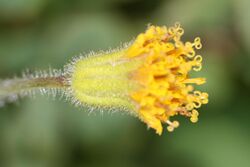Biology:Arnica parryi
| Arnica parryi | |
|---|---|

| |
| Alpine Lakes Wilderness, Washington (state) | |
| Scientific classification | |
| Kingdom: | Plantae |
| Clade: | Tracheophytes |
| Clade: | Angiosperms |
| Clade: | Eudicots |
| Clade: | Asterids |
| Order: | Asterales |
| Family: | Asteraceae |
| Genus: | Arnica |
| Species: | A. parryi
|
| Binomial name | |
| Arnica parryi Gray
| |
| Synonyms[2] | |
| |
Arnica parryi is a North American species of flowering plant known by the common names Parry's arnica or nodding arnica.[3] It is native to western Canada (Yukon, British Columbia, Alberta) and the western United States as far south as Inyo County, California and McKinley County, New Mexico. It grows in temperate coniferous forests and alpine meadows in mountainous areas, primarily the Rocky Mountains, Cascades, and Sierra Nevada.[4]
Arnica parryi is a rhizomatous perennial herb producing a single unbranched stem to heights between 10 and 60 centimeters. There are oval-shaped leaves around the base of the stem and a few pairs of longer, narrower petioled leaves above them. The leaves may approach 20 centimeters in length on larger individuals. The petioles, leaves, and flower stems and bracts are sparsely to densely coated with short white hairs. The hairs (trichomes) are sometimes glandular (with a bulbous secretory tip).[5]
The inflorescence holds one to several daisylike flower heads, which nod as buds and then pull erect when the face opens. Each head has a center filled with yellow disc florets and usually no ray florets. The fruit is a cylindrical achene about half a centimeter long with a bristly tan to brown pappus.[5][6]
References
- ↑ The International Plant Names Index
- ↑ The Plant List Arnica parryi A.Gray
- ↑ Calflora taxon report, University of California, Arnica parryi, A. Gray, Parry's arnica, nodding arnica
- ↑ Biota of North America Program 2014 county distribution map
- ↑ 5.0 5.1 Flora of North America Vol. 21 Page 373 Parry’s arnica, nodding arnica Arnica parryi A. Gray, Amer. Naturalist. 8: 213. 1874.
- ↑ Hitchcock, C.L. and Cronquist, A. 2018. Flora of the Pacific Northwest, 2nd Edition, p. 541. University of Washington Press, Seattle.
External links
- Jepson Manual Treatment
- united States Department of Agriculture Plants Profile
- Callphotos Photo gallery, University of California
Wikidata ☰ Q4794784 entry
 |

